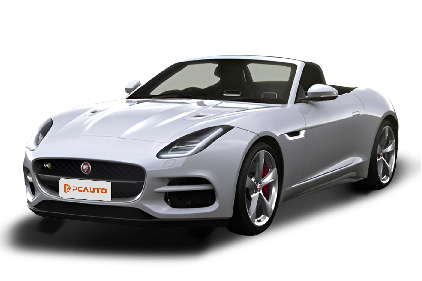

Reference Only. Update Soon
2020 Jaguar F‑TYPE Coupe
Price
RM 579,037
Summary
Core Specs
Price
Highlights
Common Problem
Other Variants
Resale Value
Dealers
Related Q&A
Summary
Drivers love the 2020 Jaguar F‑TYPE Coupe, a Sports Car Coupe launched in 2020. At RM 579,037, it’s great value. Carry 2 people easily – the roomy interior measures 4482mm long, 1923mm wide, and 1311mm tall. Ideal if you haul kids or gear but want easy city handling.
It cruises smoothly at up to 300km/h. With its 1997cc engine, you get lively acceleration without high fuel costs. For a versatile ride that’s stylish and dependable, the 2020 Jaguar F‑TYPE Coupe ticks every box.
It cruises smoothly at up to 300km/h. With its 1997cc engine, you get lively acceleration without high fuel costs. For a versatile ride that’s stylish and dependable, the 2020 Jaguar F‑TYPE Coupe ticks every box.
Core Specs
Segment
Sports Car
Engine Capacity(cc)
1997
Transmission
-
Fuel Comsumption (L/100km)
10.7
Fuel Tank(litres)
63
Top Speed(km/h)
300
Seats
2
Length(mm)
4482
Width(mm)
1923
Height(mm)
1311
Wheelbase(mm)
2622
Boot Volume(L)
408
Other Variants
Price
RM 579,037
Body
4482×1923×1311
Engine Power(PS)
300
Engine Torque(Nm)
-
TRANSMISSION
-
Fuel Consumption
10.7
Related Q&A
View More >Q
how to calculate co2 emissions from fuel consumption
To calculate the carbon dioxide (CO2) emissions generated from fuel consumption, you can use the following formula:
CO2 Emissions (kg) = Fuel Consumption (liters) × Carbon Emission Factor of the Fuel.
In Malaysia, the carbon emission factors for common fuels (like gasoline and diesel) differ. For example, gasoline produces approximately 2.3 kilograms of CO2 for every liter burned. But it's important to note that this is a rough estimate; the actual CO2 emissions can be influenced by various factors, including engine efficiency and driving conditions. For more precise calculations, professional testing equipment and techniques may be necessary.
 FrostyDec 24, 2024
FrostyDec 24, 2024Q
What is the Length of Chery Omoda 5?
The Chery Omoda 5 has a body length of 4,400 millimeters, which is a typical size for compact SUVs. It's well - suited for city driving and family use in Malaysia. It can nimbly navigate through congested roads while offering sufficient seating and storage space.
This vehicle adopts a trendy and forward - looking design language. Its wheelbase reaches 2,630 millimeters, ensuring legroom comfort for rear - seat passengers. Meanwhile, with a ground clearance of 183 millimeters, it can handle Malaysia's diverse road conditions.
In terms of power, the Omoda 5 is equipped with a 1.5 - liter turbocharged engine paired with a CVT transmission, balancing fuel economy and driving pleasure. Regarding safety features, it comes with advanced functions such as adaptive cruise control, lane - keeping assist, and a 360 - degree panoramic camera, meeting the expectations of Malaysian consumers for cost - effective models.
It's worth noting that compact SUVs are extremely popular in the Malaysian market. They can meet daily commuting needs and also offer a certain degree of versatility, making them suitable for weekend getaways or long - distance trips. The Omoda 5 is indeed a competitive new option in this segment.
 NitroBoostJul 7, 2025
NitroBoostJul 7, 2025Q
What is the Engine in Nissan Almera?
The Nissan Almera available in the Malaysian market is equipped with a 1.0 - liter three - cylinder turbocharged gasoline engine (model HR10DET). This engine adopts direct injection technology, with a maximum output power of 100 horsepower and a peak torque of up to 152 Nm. It is paired with an Xtronic CVT transmission, offering a smooth driving experience and good fuel economy. According to official data, the combined fuel consumption is approximately 5.2 liters per 100 kilometers. This small - displacement turbo engine is suitable for urban commuting, meeting both the power and energy - saving requirements, and it also complies with the environmental protection standards in the Malaysian market.
It's worth mentioning that three - cylinder turbo engines have become the mainstream choice for many brands in recent years. Their technology is quite mature and can effectively balance performance and fuel consumption. Nissan has also applied shock - absorption technology to this engine to optimize its smooth operation. If you have higher power requirements, you can refer to the 1.5 - liter naturally aspirated engines of its competitors in the same class, such as the Honda City or Toyota Vios. However, the turbocharging feature of the Almera can provide more direct torque output at low speeds, making it suitable for the stop - and - go traffic environment in Malaysia.
 UipJul 29, 2025
UipJul 29, 2025Q
Where is the USB port of the Mazda CX-5?
The USB port of the Mazda CX-5 is generally inside the storage compartment of the center console, within the center armrest box, or below the rear air conditioning vent. However, the specific location may vary depending on the vehicle configuration and model year.
 BikerzzApr 1, 2025
BikerzzApr 1, 2025Q
What is the BYD M6 Size? How Big Is It?
The BYD M6 has a body length of 4,710 mm, a width of 1,810 mm, a height of 1,690 mm, and a wheelbase of up to 2,800 mm. These dimensions give it an edge in the compact MPV segment, providing relatively spacious interior room.
The 2+3+2 seven - seat layout further enhances its space practicality. Even in the third row, passengers can enjoy reasonable legroom without feeling overly cramped. Whether it's for the daily outings of a large family or other uses, the size and seat layout of the M6 make it a practical choice. The vehicle's dimensions also offer a relatively stable driving experience. A longer wheelbase helps to achieve better balance and handling during driving.
 HunterQuestAdventureJul 15, 2025
HunterQuestAdventureJul 15, 2025Q
Does Toyota Yaris Support Apple Carplay?
Some high - end models of the Toyota Yaris are indeed equipped with multimedia touch display system that supports Apple CarPlay (this depends on the year and model). You can directly connect your iPhone via USB to use functions such as navigation, music, and calls, which enhances driving convenience. However, it should be noted that the entry - level versions may only be equipped with a basic audio system and do not support CarPlay. It is recommended to confirm the specific configuration with the dealer before purchasing a car.
In recent years, Toyota has gradually popularized intelligent connectivity features in many models. Apple CarPlay has become one of the factors considered by many Malaysian consumers before purchasing the vehicle. In addition to CarPlay, some versions may also support Android Auto, allowing users to access their phone functions more flexibly. If your Yaris was made in an earlier year and doesn't have this feature pre - installed, you can also consult the original manufacturer or the authorized service center to see if there is a solution to upgrade the host system.
 FopJun 25, 2025
FopJun 25, 2025Q
When is the Release Date of Toyota Corolla Cross?
The Toyota Corolla Cross was launched in Malaysia in October 2020. As an important SUV model of Toyota in the Southeast Asian market, this vehicle quickly gained popularity among local consumers with its stylish appearance, practical space, and reliable performance. The Corolla Cross comes in two versions: a 1.8L naturally aspirated version and a 1.8L hybrid version, which balance fuel economy and power performance. Its safety features are also quite extensive, including Toyota's TSS (Toyota Safety Sense) intelligent safety system, meeting the needs of Malaysian users for high-value models.
It's worth mentioning that the main competitors of the Corolla Cross in the Malaysian market include the Honda HR-V and the Mazda CX-30. Each of these models has its own unique features, and consumers can make a choice based on their preferences. For Malaysian users looking to buy a new car, besides paying attention to the launch time, they can also keep an eye on the regular promotional activities launched by Toyota, such as low - interest loans or free maintenance services. These offers can further reduce the cost of car ownership. With the continuous development of the Malaysian automotive market, compact SUVs like the Corolla Cross are expected to remain highly popular due to their flexibility and practicality.
 BooJul 4, 2025
BooJul 4, 2025Q
Is the Proton S70 Heavier Than the X50?
The weight of the Proton S70 is approximately between 1,325 kg and 1,345 kg, depending on different versions. Meanwhile, the Proton X50 weighs between 1,300 kg and 1,330 kg. There isn't a significant difference in weight between the two, but as a three - box sedan, the S70's body structure focuses more on high - speed stability, so it's slightly heavier. In contrast, as a compact SUV, the X50's body design leans more towards flexibility and passability, and its weight distribution is also different.
In the Malaysian market, both models adopt Proton's latest technological platforms. The S70 is built on the BMA platform, while the X50 shares the platform with the Geely Binyue. Both cars have done well in lightweight design, ensuring body rigidity while also taking fuel economy into account.
For consumers, when making a choice, besides the weight, they can also consider space requirements, driving habits, and usage scenarios. For example, the S70 is more suitable for long - distance driving, while the X50 is better for urban commuting and occasional light off - road driving. Both cars demonstrate Proton's advantages in local production and tuning, and can well adapt to the road conditions and climate in Malaysia.
 MusicianAug 6, 2025
MusicianAug 6, 2025Q
how to open proton saga door panel
To open Proton Saga's door panel,
1. Prepare the appropriate tools, such as a screwdriver.
2. Locate the screws that fasten the door's interior panel around the edges, which are typically found near the door handle, armrest, and other similar places.
3. Carefully remove these screws, then use a plastic pry tool to gently pry open the edge of the door panel, gradually releasing the clips.
4. Be careful not to apply too much force to avoid damaging any components.
During the process, ensure your movements are gentle and steady.
 DiverMar 5, 2025
DiverMar 5, 2025Q
What is the Service Price of Toyota Vios? Better Look At Here First
The maintenance cost of the Toyota Vios in Malaysia varies depending on the service items and the age of the vehicle. The first service (at 1,000 km or 1 month) is usually free. Subsequent regular maintenance (every 10,000 km or 6 months) typically costs around RM200 to RM400, covering engine oil, filter replacement, and basic inspections. For major mileage services (such as at 40,000 km or 60,000 km), additional replacements like brake fluid, transmission oil, or spark plugs may be required, pushing the cost up to RM600 to RM1,200. The actual price depends on labor charges and parts options at authorized service centers.
Owners are advised to follow scheduled maintenance to keep the vehicle performing well. They can also check the official Toyota website or the MyTAPP app for the latest promotional packages, as discounts or free inspections may be available during certain periods. Driving habits also affect maintenance costs—frequent short-distance trips or intensive use may accelerate wear and tear. Paying attention to daily maintenance, such as tire pressure and fluid levels, can help reduce long-term expenses. Given Malaysia’s hot climate, replacing the air-conditioning filter slightly more frequently than recommended in the manual is advisable to ensure cabin air quality and system efficiency.
 WhisperingWindJul 7, 2025
WhisperingWindJul 7, 2025